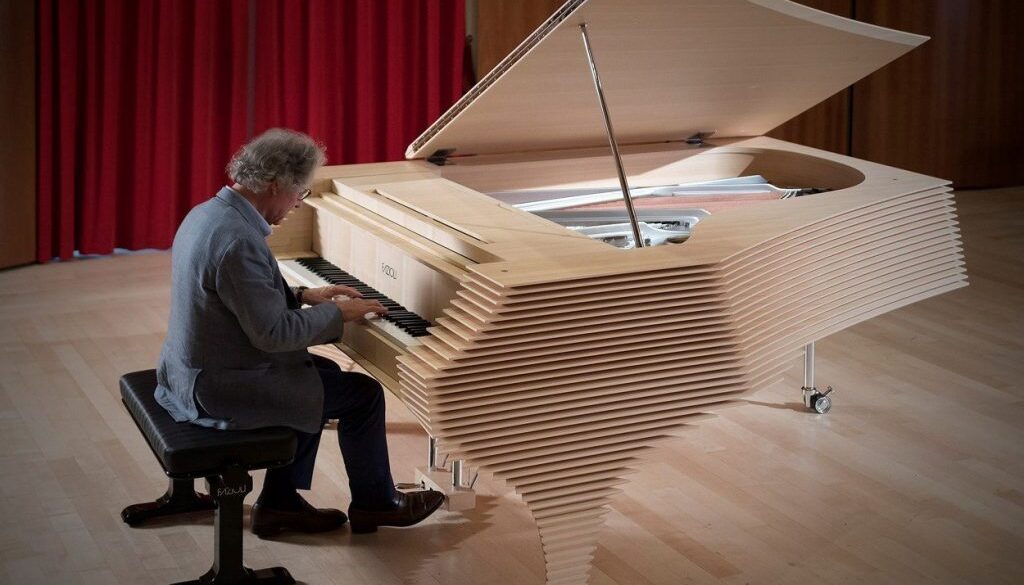Kengo Kuma and Fazioli – A Meeting in the Moss Garden

When a world-renowned Japanese architect, Kengo Kuma was commissioned by Canadian firm Westbank Corporation, an avant-garde developer, to design a residential tower in downtown Vancouver, it was to be part of a larger project. Westbank, in partnership with the QuadReal Property Group, is re-developing Vancouver’s 28-acre Oakridge commercial area into a modern municipal town center. It is a massive undertaking that should be completed in 2023.
Westbank is taking a unique and uber modern approach to their Oakridge cultural project. Their intention is to transform the cookie-cutter urban sprawl of vertical condos which describes the banal architecture in Vancouver since the 1990’s into a contemporary vista of artful and progressive unified cultural vista. Using a collaborative conglomeration of architects and designers, the landscape is changing radically. Vancouver is undergoing the largest architectural renaissance in its history. Westgate wants to enhance Vancouver’s natural surroundings and Asian heritage with innovative and transformative structures. (Forty-three per cent of Metro Vancouver residents have an Asian heritage, which is a much higher proportion than any other major city outside the continent of Asia.)
The first of the new designated buildings is at 1550 Alberni Street, a 43-story high-rise tower’s with private living units aloft and ground floor commercial spaces. True to Westbank’s principles, their intention was to transcend the traditional, and make a remarkable residential tower that suited the whole vision. Kengo Kumo was a natural choice for the job because of his affinity for meshing design with nature; his Asian style and ideas aligned perfectly with Westgate’s goal.
In Vancouver, which sits on the ocean, nature plays a major role in the ambiance and spirit of the city. The design of Alberni tower creates a connection with the environment, with the use of woods, irregular shapes and flowing lines. Every living unit in the building is designed to have a view – ocean or mountains, to fulfill the connections to nature for residents.
Kengo Kuma has designed an orthogonal tower, – as if the sky has taken diagonally symmetrical bites out of it, two sides scooped out, exposing jutting balconies furnished in wood, a dazzling innovative design feat.
Because of the way the otherwise orthogonal tower is carved, its silhouette creates illusionary profiles of arching cantilevers in constant change. The lower portion helps to counterbalance the towering volume above.

The tower meets the ground with two intersecting domes that embrace Alberni and Cardero streets. Under the arching structures on the ground floor, Kengo Kuma has designed a Japanese moss garden, sculpted with paths providing walk-throughs from one block to another, affording pedestrians a serene departure from the city streets. Wood shapes and wood details are emphasized throughout Alberni, paired with the mossy green, bringing nature to the cityscape.
The moss garden defines the entrance and flows to the swimming pool above. In keeping with Japanese spatial traditions, the emphasis is not on object but ambiance: without drawing attention to a particular thing, the atmosphere elicits a serene visceral experience that could be shared by all.
1550 Alberni will include intricate design details such as woodwork in the plinth, interior design of residential tower, and a Japanese Restaurant experience.
Kengo Kuma is quoted as saying, “…in the 20th century wood disappeared from the city, but before the 20th century we were living with wood, the warmth of wood, the softness of wood. So, I would like to go back to that kind of lifestyle. Now. With contemporary technology we can make it happen. The wood changes the atmosphere of the building, totally different from the typical towers. Some of it is inside, some is outside.”
In addition to the natural greenery, the garden is designed as a mini-amphitheater to host musical events in the enclosure, in the best community spirit.

In keeping with Westbank’s vision for community involvement, they commissioned the creation of a one-of-a-kind signature piano to add as the focal centerpiece to the garden as a musical showcase.
When people talk about the best pianos in the world, there is one name that always stands out. The Italian piano builder Paolo Fazioli, the engineer/musician/entrepreneur who changed the industry with new unmatched performance values and incredible grand piano art cases, made his mark, starting in 1978. His factory is located in Sacile, Italy, outside of Venice.
Westbank and Fazioli have a long relationship. Fazioli has been commissioned several times to build luxury designer pianos for Westbank’s properties. Each piano is high-end unique art piece worthy of its own blog article.

For the Alberni project, Fazioli’s F212 seven-foot model grand piano was used, a perfect size for small concert spaces and hotel lobbies.
The performance quality of Fazioli pianos is always of the highest standard, and the building’s thematic wood dictated the piano case. But as always, Kengo Kuma took it to the most artful extreme in collaboration with Paolo Fazioli. Japanese Hinoki was the wood chosen to handmake the piano case. Hinoki is one of the most highly prized woods grown only in Japan, a type of cypress considered “sacred.” The wood is naturally perfumed and lemon-scented, distinguished by its straight grain and beautiful light color. For centuries the hinoki has been used for palaces, temples and shrines, as well as for Bonsai and ornamentals sold across the world. The uniform grain of Hinoki makes it a perfect wood for the piano builder, both acoustically and aesthetically. The Kengo Kuma Fazioli grand piano took over a year to build and cost $890,000. U.S.
The piano case is shaped from intricate stacked tiers of Hinoki to echo the sculptured look of the Alberni architecture. The parallel striated patterns of the light -colored wood make a beautiful design on the lid, lyre and keyboard of the instrument.
Until the completion of the building, the Alberni Fazioli will be housed at the offices of Kengo Kuma and Associates.

Since the commencement of the Alberni building, in 2016 (and to be completed by 2020) Westgate has announced its plans for the Jenga building, the next striking residential property. Many more futuristic buildings are in the works, including the Butterfly building with its own Fazioli grand piano.
Other Westgate/Fazioli collaborations have been:
- A special piano for the Shangri-La Hotel, Vancouver, designed to match the hotel’s interior wood paneling (2008)
- A stunning white piano with an intricate walnut inlay, for Vancouver’s Fairmont Pacific Rim hotel (2010)
- The “Joni Mitchell” Fazioli for Toronto’s Shangri-La hotel (2012)
- The TELUS Piano for Vancouver’s TELUS Garden Development (2015)
- The Butterfly Fazioli, for the lobby of Vancouver’s downtown “The Butterfly” building (2017).

